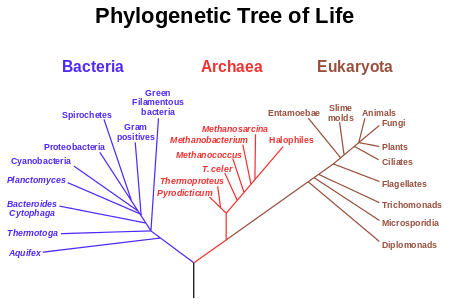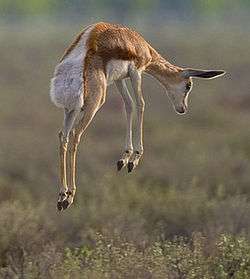Tree of life (biology)

The tree of life or universal tree of life is a metaphor used to describe the relationships between organisms, both living and extinct, as described in a famous passage in Charles Darwin's On the Origin of Species (1859).
Tree-diagrams originated in the medieval era to represent genealogical relationships.
Phylogenetic tree diagrams in the evolutionary sense date back to at least the early 19th century.
The term phylogeny for the evolutionary relationships of species through time was coined by Ernst Haeckel, who went further than Darwin in proposing phylogenic histories of life. In contemporary usage, tree of life refers to the compilation of comprehensive phylogenetic database rooted at the last universal common ancestor of life on Earth. The Open Tree of Life, first published 2015, is a project to compile such a database for free public access.
Early phylogenetic trees

| Part of a series on |
| Evolutionary biology |
|---|
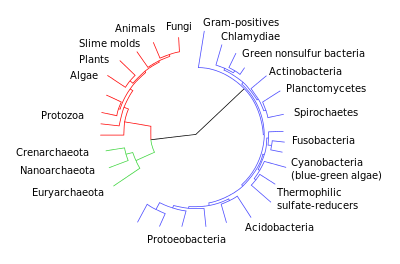 |
|
History of evolutionary theory |
|
Fields and applications
|
|
Although the mutability of species may have appeared in paintings[2] and trees have been used as a metaphor for other purposes (Porphyrian tree) earlier than 1800, the combination of the concept of branching evolution and the tree image did not appear before 1800. The earliest tree of life was published by the French botanist Augustin Augier in 1801. It shows the relationships between members of the plant kingdom.
Jean-Baptiste Lamarck (1744–1829) produced the first branching tree of animals in his Philosophie Zoologique (1809). It was an upside-down tree starting with worms and ending with mammals. However, Lamarck did not believe in common descent of all life. Instead, he believed that life consists of separate parallel lines advancing from simple to complex.[3]
The American geologist Edward Hitchcock (1793–1864) published in 1840 the first tree of life based on paleontology in his Elementary Geology.[4] On the vertical axis are paleontological periods. Hitchcock made a separate tree for plants (left) and animals (right). The plant and the animal tree are not connected at the bottom of the chart. Furthermore, each tree starts with multiple origins. Hitchcock's tree was more realistic than Darwin's 1859 theoretical tree (see below) because Hitchcock used real names in his trees. It is also true that Hitchcock's trees were branching trees. However, they were not evolutionary trees, because Hitchcock believed that a deity was the agent of change. That was an important difference with Darwin.
The first edition of Robert Chambers' Vestiges of the Natural History of Creation, which was published anonymously in 1844 in England, contained a tree-like diagram (p. 212) in the chapter "Hypothesis of the development of the vegetable and animal kingdoms". It shows a model of embryological development where fish (F), reptiles (R), and birds (B) represent branches from a path leading to mammals (M). In the text this branching tree idea is tentatively applied to the history of life on earth: "there may be branching" (p. 191), but the branching diagram is not displayed again specifically for this purpose.[5] However, the image of a branching tree could easily have inspired others to use it explicitly as a representation of the history of life on earth.
In 1858, a year before Darwin's Origin, the paleontologist Heinrich Georg Bronn (1800–1862) published a hypothetical tree labeled with letters. Although not a creationist, Bronn did not propose a mechanism of change.[6]
Darwin
Charles Darwin (1809–1882) used the concept of a tree of life in the context of his theory of evolution. In On the Origin of Species (1859) Chapter IV he presented an abstract diagram of a theoretical tree of life for species of an unnamed large genus (see figure). On the horizontal base line hypothetical species within this genus are labelled A – L and are spaced irregularly to indicate how distinct they are from each other, and are above broken lines at various angles suggesting that they have diverged from one or more common ancestors. On the vertical axis divisions labelled I – XIV each represent a thousand generations. From A, diverging lines show branching descent producing new varieties, some of which become extinct, so that after ten thousand generations descendants of A have become distinct new varieties or even sub-species a10, f10, and m10. Similarly, the descendants of I have diversified to become the new varieties w10 and z10. The process is extrapolated for a further four thousand generations so that the descendants of A and I become fourteen new species labelled a14 to z14. While F has continued for fourteen thousand generations relatively unchanged, species B,C,D,E,G,H,K and L have gone extinct. In Darwin's own words: "Thus the small differences distinguishing varieties of the same species, will steadily tend to increase till they come to equal the greater differences between species of the same genus, or even of distinct genera.".[7] This is a branching pattern with no names given to species, unlike the more linear tree Ernst Haeckel made years later (figure below) which includes the names of species and shows a more linear development from "lower" to "higher" species. In his summary to the section, Darwin put his concept in terms of the metaphor of the tree of life:
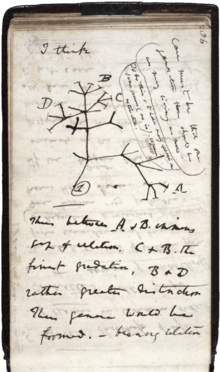
The affinities of all the beings of the same class have sometimes been represented by a great tree. I believe this simile largely speaks the truth. The green and budding twigs may represent existing species; and those produced during each former year may represent the long succession of extinct species. At each period of growth all the growing twigs have tried to branch out on all sides, and to overtop and kill the surrounding twigs and branches, in the same manner as species and groups of species have tried to overmaster other species in the great battle for life. The limbs divided into great branches, and these into lesser and lesser branches, were themselves once, when the tree was small, budding twigs; and this connexion of the former and present buds by ramifying branches may well represent the classification of all extinct and living species in groups subordinate to groups. Of the many twigs which flourished when the tree was a mere bush, only two or three, now grown into great branches, yet survive and bear all the other branches; so with the species which lived during long-past geological periods, very few now have living and modified descendants. From the first growth of the tree, many a limb and branch has decayed and dropped off; and these lost branches of various sizes may represent those whole orders, families, and genera which have now no living representatives, and which are known to us only from having been found in a fossil state. As we here and there see a thin straggling branch springing from a fork low down in a tree, and which by some chance has been favoured and is still alive on its summit, so we occasionally see an animal like the Ornithorhynchus or Lepidosiren, which in some small degree connects by its affinities two large branches of life, and which has apparently been saved from fatal competition by having inhabited a protected station. As buds give rise by growth to fresh buds, and these, if vigorous, branch out and overtop on all sides many a feebler branch, so by generation I believe it has been with the great Tree of Life, which fills with its dead and broken branches the crust of the earth, and covers the surface with its ever branching and beautiful ramifications.
The meaning and importance of Darwin's use of the tree of life metaphor have been extensively discussed. Stephen Jay Gould, for example, says that Darwin placed the famous passage quoted above "at a crucial spot in his text", where it marked the conclusion of his argument for natural selection, illustrating both the interconnectedness by descent of organisms as well as their success and failure in the history of life.[9] David Penny has written that Darwin did not use the tree of life to describe the relationship between groups of organisms, but to suggest that, as with branches in a living tree, lineages of species competed with and supplanted one another.[10] Petter Hellström has demonstrated that Darwin consciously chose to name his tree after the biblical tree of life, as described in Genesis, thus relating his theory to Christian mythology, and suggesting that he did so to mobilise the imagination of his readers.[11]
Haeckel
 Haeckel's Stammbaum der Primaten (1860s)
Haeckel's Stammbaum der Primaten (1860s) Tree of life in Generelle Morphologie der Organismen (1866), Ernst Haeckel.
Tree of life in Generelle Morphologie der Organismen (1866), Ernst Haeckel.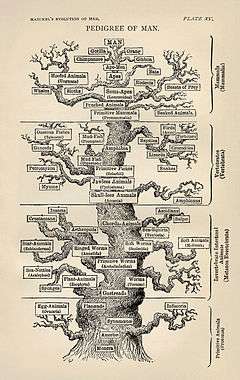 The tree of life as seen by Ernst Haeckel in the The Evolution of Man (1879)
The tree of life as seen by Ernst Haeckel in the The Evolution of Man (1879)
Ernst Haeckel (1834–1919) constructed several trees of life. Left is shown the first sketch of the famous Haeckel's tree of life in the 1870s which shows "Pithecanthropus alalus" as the ancestor of Homo sapiens. In the middle is the tree of life from Generelle Morphologie der Organismen (1866) with three kingdoms Plantae, Protista and Animalia. On the right is the 'Pedigree of Man' published in The Evolution of Man (1879).
Contemporary usage
The model of a tree is still considered valid for eukaryotic life forms. As of 2010, research into the earliest branches of the eukaryote tree has suggested a tree with either four supergroups[12][13] or two supergroups.[14] There does not yet appear to be a consensus; in a review article, Roger and Simpson conclude that "with the current pace of change in our understanding of the eukaryote tree of life, we should proceed with caution."[15]
In September 2015, the first draft of the Open Tree of Life was published, in which information from nearly 500 previously published trees was combined into a single online database, free to browse and download.[16]
In April 2016, a new tree of life, summarizing the evolution of all known life forms, was published, finding that the branches of the new overview, based on the latest genetic findings, were mainly composed of bacteria. The new study incorporated over a thousand newly discovered bacteria and archaea.[17][18][19]
Horizontal gene transfer
The prokaryotes (the two domains of bacteria and archaea) and certain animals such as bdelloid rotifers[20] and the tardigrade[21] have the ability to transfer genetic information between unrelated organisms through horizontal gene transfer. Recombination, gene loss, duplication, and gene creation are a few of the processes by which genes can be transferred within and between bacterial and archaeal species, causing variation that is not due to vertical transfer.[22][23][24] There is emerging evidence of horizontal gene transfer within the prokaryotes at the single and multicell level, so the tree of life does not explain the full complexity of the situation in the prokaryotes.[23]

See also
Footnotes
- ↑ Hug, Laura A.; Baker, Brett J.; Anantharaman, Karthik; Brown, Christopher T.; Probst, Alexander J.; Castelle, Cindy J.; Butterfield, Cristina N.; Hernsdorf, Alex W.; Amano, Yuki; Ise, Kotaro; Suzuki, Yohey; Dudek, Natasha; Relman, David A.; Finstad, Kari M.; Amundson, Ronald; Thomas, Brian C.; Banfield, Jillian F. (11 April 2016). "A new view of the tree of life". Nature Microbiology: 16048. doi:10.1038/nmicrobiol.2016.48.
- ↑ Fausto Barbagli (2009) 'In Retrospect: The earliest picture of evolution?', Nature 19 November 2009
- ↑ Peter J. Bowler (2003) 'Evolution. The History of an Idea', third edition, p.90-91.
- ↑ J. David Archibald (2009) 'Edward Hitchcock’s Pre-Darwinian (1840) 'Tree of Life'.', Journal of the History of Biology (2009) 42:561–592
- ↑ See for online edition of Vestiges.
- ↑ J. David Archibald (2009) 'Edward Hitchcock’s Pre-Darwinian (1840) 'Tree of Life'.', Journal of the History of Biology (2009) page 568.
- ↑ Darwin 1859, pp. 116–130
- ↑ Darwin 1859, pp. 129–130
- ↑ Gould, Stephen Jay (1993). Eight Little Piggies. London: Jonathan Cape. ISBN 0-224-03716-1. p. 300
- ↑ Penny, D. (2011). "Darwin's Theory of Descent with Modification, versus the Biblical Tree of Life". PLoS Biology. 9 (7): e1001096. doi:10.1371/journal.pbio.1001096.
- ↑ Nils Petter Hellström (2012). "Darwin and the tree of life: the roots the evolutionary tree", Archives of natural history 39 (2), pp. 234–252, doi:10.3366/anh.2012.0092
- ↑ Burki, Fabien; Shalchian-Tabrizi, Kamran & Pawlowski, Jan (2008), "Phylogenomics reveals a new 'megagroup' including most photosynthetic eukaryotes", Biology Letters, 4 (4): 366–369, doi:10.1098/rsbl.2008.0224, PMC 2610160
 , PMID 18522922
, PMID 18522922 - ↑ Apollon: The Tree of Life Has Lost a Branch
- ↑ Kim, E.; Graham, L.E.; Redfield, Rosemary Jeanne (2008), Redfield, Rosemary Jeanne, ed., "EEF2 analysis challenges the monophyly of Archaeplastida and Chromalveolata", PLoS ONE, 3 (7): e2621, Bibcode:2008PLoSO...3.2621K, doi:10.1371/journal.pone.0002621, PMC 2440802
 , PMID 18612431
, PMID 18612431 - ↑ Roger, A.J. & Simpson, A.G.B. (2009), "Evolution: Revisiting the Root of the Eukaryote Tree", Current Biology, 19 (4): R165–7, doi:10.1016/j.cub.2008.12.032, PMID 19243692
- ↑ "First comprehensive tree of life shows how related you are to millions of species"|>
- ↑ Zimmer, Carl (11 April 2016). "Scientists Unveil New 'Tree of Life'". New York Times. Retrieved 11 April 2016.
- ↑ Taylor, Ashley P. (11 April 2016). "Branching Out: Researchers create a new tree of life, largely comprised of mystery bacteria". The Scientist. Retrieved 11 April 2016.
- ↑ Hug, Laura A.; Baker, Brett J.; Anantharaman, Karthik; et al. (11 April 2016). "A new view of the tree of life". Nature Microbiology: 16048. doi:10.1038/nmicrobiol.2016.48. Retrieved 11 April 2016.

- ↑ Watson, Traci (15 November 2012). "Bdelloids Surviving on Borrowed DNA". Science/AAAS News.
- ↑ Koutsovoulos, Georgios; Kumar, Sujai; Laetsch, Dominik R.; Stevens, Lewis; Daub, Jennifer; Conlon, Claire; Maroon, Habib; Thomas, Fran; Aboobaker, Aziz (2015-12-13). "The genome of the tardigrade Hypsibius dujardini". bioRxiv: 033464. doi:10.1101/033464.
- ↑ Jain R, Rivera MC, Lake JA (1999), "Horizontal gene transfer among genomes: the complexity hypothesis", Proc Natl Acad Sci U S A, 96 (7): 3801–6, Bibcode:1999PNAS...96.3801J, doi:10.1073/pnas.96.7.3801, PMC 22375
 , PMID 10097118
, PMID 10097118 - 1 2 Graham Lawton Why Darwin was wrong about the tree of life New Scientist Magazine issue 2692 21 January 2009 Accessed Feb 2009
- ↑ Doolittle, W. Ford (February, 2000). Uprooting the tree of life. Scientific American 282 (6): 90–95.
References
- Darwin, Charles (1859), On the Origin of Species by Means of Natural Selection, or the Preservation of Favoured Races in the Struggle for Life (1st ed.), London: John Murray, ISBN 1-4353-9386-4
- Darwin, Charles (1872), The Origin of Species by Means of Natural Selection, or the Preservation of Favoured Races in the Struggle for Life (6th ed.), London: John Murray, ISBN 1-4353-9386-4
- Doolittle, W. F.; Bapteste, E. (2007). "Inaugural Article: Pattern pluralism and the Tree of Life hypothesis". Proceedings of the National Academy of Sciences. 104 (7): 2043–2049. doi:10.1073/pnas.0610699104. PMC 1892968
 . PMID 17261804.
. PMID 17261804.
External links
- Tree of Life Web Project - explore complete phylogenetic tree interactively
- Tree of Life Evolution Links species on Earth through a shared evolutionary history
- Science journal issue - Issue devoted to the tree of life.
- The Tree of Life by Garrett Neske, The Wolfram Demonstrations Project: "presents an interactive tree of life that allows you to explore the relationships between many different kinds of organisms by allowing you to select an organism and visualize the clade to which it belongs."
- The Green Tree of Life - Hyperbolic tree University of California/Jepson Herbaria
- NCBI's taxonomy database common tree
